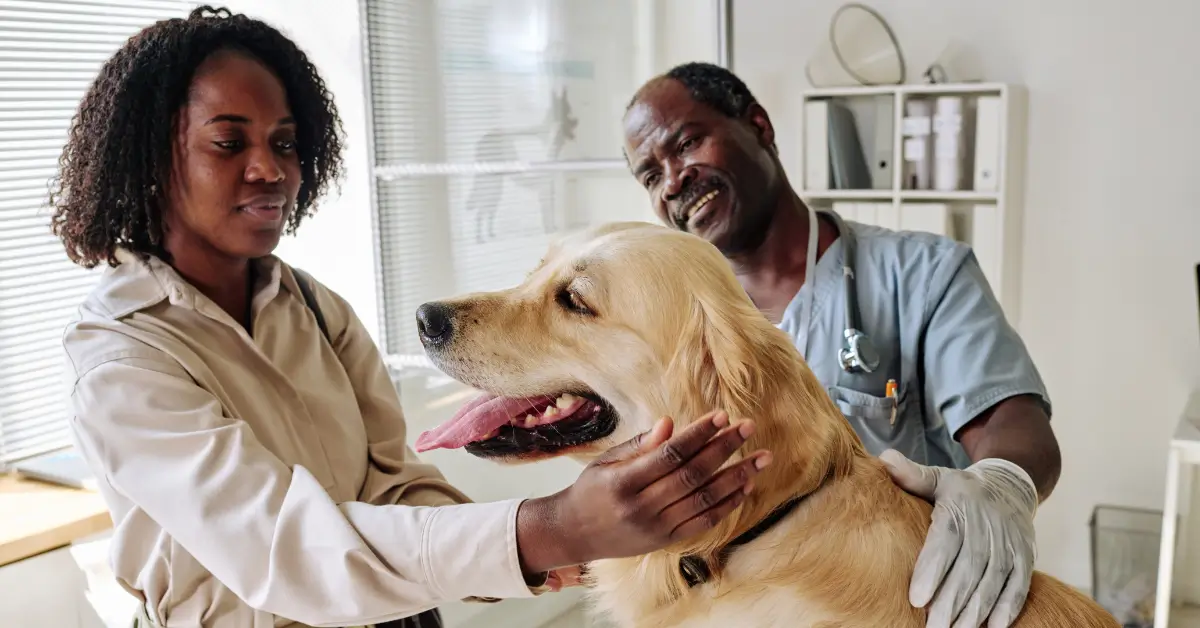Taking your aggressive dog to the vet doesn’t have to be a nerve-wracking ordeal. If you’re wondering how to take an aggressive dog to the vet smoothly, you’re not alone. Many pet owners face this challenge, but there are ways to make it less stressful for both you and your furry companion.
In this article, we’ll explore some practical steps and strategies to help your dog stay calm and cooperative during vet visits. From understanding your dog’s aggressive signals to teaming up with behavior experts, we’ve got you covered.
Our goal is to transform a potentially daunting task into a manageable, and even positive, experience for everyone involved. Let’s dive in and discover how preparation and understanding can make all the difference.
Understanding Your Dog’s Aggressive Signals
Identifying What Sets Off Your Dog’s Aggression
Identifying what makes your dog become aggressive is the first step to a smoother visit to the vet. Dogs often show aggression due to fear or anxiety. When they growl, snap, or get into a defensive stance, it’s their way of dealing with scary situations. This might happen when they’re entering the vet clinic, which is a place full of unknown smells and sounds. It’s important to see these signs early, so you can help your dog feel better before they become too upset.
Reading Your Dog’s Body Language and Vocal Clues
Reading your dog’s body language and listening to their vocal cues are key to understanding how they feel. A tucked tail or pinned-back ears can mean your dog is on edge. When your dog barks or growls, they might be trying to tell you they’re scared or anxious, especially in stressful places like the vet’s office. Knowing your dog means you can make their vet visits less of a nightmare.
Pre-Vet Prep for Your Feisty Furry Friend
Training and Calming Strategies Before the Appointment
Prepping your dog for the vet isn’t just about the visit itself. Start at home by giving your dog some exercise to help them get rid of nervous energy. This can make entering the vet clinic a lot less stressful. Teaching your dog to be calm when being touched, like during a check-up, is part of dog training that makes a big difference. Positive reinforcement, like treats and praise, can turn a vet visit into a more positive experience. When your dog behaves well, let them know they’ve done a great job. This way, they’ll start to associate the vet with good things.
Muzzle Mastery: Ensuring Safety and Serenity
For dogs that might snap or bite when they’re anxious, learning to wear a muzzle comfortably can be very helpful. It keeps everyone safe during the visit. Introduce the muzzle in a gentle way at home, so your dog doesn’t only associate it with the vet. This can help your dog feel at ease and prevent their anxiety from turning into aggression.
Making the Vet Visit as Smooth as Possible
Effective Communication with Your Vet Team
Remember, visits to the vet can be stressful for dogs, especially if they’re already prone to feeling anxious. But with a bit of preparation, you can help your dog handle the visit more smoothly. Always keep your dog on a leash and inform the vet about any concerns you have regarding your dog’s behavior. This way, the vet is ready to make the visit as calm and stress-free as possible.
Knowing the breed and specific fears of your dog can also help the vet and the staff prepare and provide the right kind of care, making the experience better for your dog and less worrying for you.
Crafting a Stress-Free Zone at the Clinic
To ensure a stress-free vet visit for dogs prone to anxiety or aggression, it’s beneficial to inform the vet about your dog’s specific triggers and behaviors ahead of time. Many clinics offer quiet waiting areas to minimize stress, and knowing a dog’s breed can help vets tailor their care approach, potentially using sedatives for highly fearful dogs. Proper preparation and communication with your vet can significantly reduce stress for both the dog and owner during vet visits.
Caring for Your Dog After the Vet Visit
Celebrating Your Dog’s Bravery with Positive Reinforcement
Using positive reinforcement after vet visits, like treats and praise, can help dogs associate these visits with positive experiences. This approach gradually reduces their anxiety, making future visits easier to handle. It’s similar to learning anything new; with positive feedback and practice, what once seemed daunting becomes manageable. Thus, vet visits can evolve from stressful experiences into just another routine event for both the dog and owner.
Keeping Tabs: The Importance of Aftercare
Monitoring your dog’s behavior and physical condition after the vet visit is crucial, especially if they were sedated or if the visit was particularly stressful. Watch for any signs of discomfort or unusual behavior and don’t hesitate to contact your vet if you have concerns. Regular, calm check-ins can help reassure your dog and keep them comfortable after the visit.
Teaming Up with Experts for Your Dog’s Best Behavior
Finding the Perfect Behavior Expert for Your Dog
For dogs with severe anxiety or aggression, working with a professional dog behaviorist can be incredibly beneficial. A behaviorist can provide tailored advice and strategies based on your dog’s specific needs, helping to manage their aggression more effectively. When choosing a behaviorist, look for someone with experience in dealing with similar issues and a gentle, positive approach to training.
Harmonizing Professional Guidance with Daily Routine
Incorporating a behaviorist’s advice into your daily routine with your dog can lead to significant improvements in their behavior. Consistency is key—regular training sessions, consistent commands, and calm, assertive leadership can help your dog feel more secure and reduce their aggressive tendencies. Remember, changing behavior takes time and patience, but with persistent effort and professional support, you can help your dog become more relaxed and confident, even in situations that previously caused them stress
Conclusion
Taking an aggressive dog to the vet can challenge even the most experienced dog owners. However, with proper preparation, understanding, and support, it’s possible to transform what could be a stressful ordeal into a manageable, and eventually, a routine experience. By employing the strategies discussed, from understanding your dog’s behavior to engaging with professional help, you can ensure a safer and more positive vet visit for both your dog and everyone involved.
Remember, each dog is unique, and what works for one may not work for another. Be prepared to adapt your approach based on your dog’s responses and continue to work towards making vet visits a less stressful experience. With time, patience, and the right support, you can help your dog overcome their fears and ensure their well-being during vet visits and beyond.
FAQ
Q: How can I take my aggressive dog to the vet?
A: If your dog is aggressive or becomes aggressive when visiting the vet, it’s essential to inform your veterinarian beforehand. They can offer guidance on how to handle the situation and may recommend sedation if necessary.
Q: What should I do if my dog is aggressive at the vet?
A: Understanding your dog’s behavior and triggers is crucial. Consider consulting a dog trainer to work on your dog’s aggression properly. In some cases, the vet may need to sedate the dog for a smooth visit.
Q: How can I help my dog have a positive experience at the vet?
A: To help your dog have a positive experience at the vet, give your dog time to get used to the clinic environment. Use positive reinforcement and treats to reward good behavior during the visit.
Q: Should I schedule extra time for my aggressive dog’s vet visit?
A: Yes, it’s a good idea to schedule extra time for your dog’s vet visit, especially if your dog has been aggressive in the past. This allows for a more relaxed and less rushed visit.
Q: What can I do if my dog snaps at the vet during the exam?
A: If your dog snaps at the vet during the exam, consider using a muzzle for safety. It’s important to address this behavior with a professional to prevent future incidents.
Q: How can I make my dog feel at ease when entering the vet clinic?
A: To make your dog feel at ease when entering the vet clinic, keep them on a leash and under control. Avoid crowded waiting areas and try to enter through a door where your dog feels more comfortable.
Q: What steps can I take to ensure my dog’s next vet visit goes smoothly?
A: Get to know your dog’s triggers and anxieties, work with a professional trainer if needed, and communicate with the veterinarian about your dog’s behavior. This can help make future visits less stressful for both you and your pet.



